Showfoto/Curves Adjust/ca: Difference between revisions
Created page with "El problema en aquesta fotografia, és que hi ha parts de la imatge que són molt fosques. Les dues persones a la foto estan clares, però el fons és tan fosc que en realitat..." |
Created page with "Com podeu veure, algunes parts de la imatge desapareixen si intentem utilitzar l'eina nivells. Què vol dir això? Això vol dir que tenim parts de la imatge al costat dret de..." |
||
| Line 16: | Line 16: | ||
[[Image:Tut2 2.png|center|400px]] | [[Image:Tut2 2.png|center|400px]] | ||
Com podeu veure, algunes parts de la imatge desapareixen si intentem utilitzar l'eina nivells. Què vol dir això? Això vol dir que tenim parts de la imatge al costat dret de l'histograma que han estat convertides a blanc. Això és deu, a diferència de la guia d'aprenentatge anterior, a que aquesta imatge no es concentra sobre la part esquerra de l'histograma. Cobreix la seva totalitat. I quan es retalla l'histograma amb els controls lliscants d'entrada, ens estem «menjant» part de la informació. | |||
Why does this happen? Because the photo scenario had a very ''High Dynamic Range''. i.e. it had objects from very dark (background) to very bright (illuminated by flash). | Why does this happen? Because the photo scenario had a very ''High Dynamic Range''. i.e. it had objects from very dark (background) to very bright (illuminated by flash). | ||
Revision as of 17:25, 11 December 2012
Guia d'aprenentatge de fotos al KDE 1-2: Ajust de corbes
Unai Garro (uga): estiu de 2008
Aquesta és la segona part de les guies d'aprenentatge dirigides a mostrar com utilitzar les eines de fotografia del KDE (anomenades ShowFoto i/o Krita), per a processar, editar i corregir les vostres fotografies. La primera part mostra com interpretar un histograma, i com utilitzar l'eina nivells. Aquesta guia d'aprenentatge us mostrarà com utilitzar una eina més avançada, anomenada Ajust de corbes. És molt més poderosa que l'eina nivells, però requereix més paciència i pràctica per obtenir bons resultats.
Així que comencem. Tenim aquesta foto, amablement donada per a la guia d'aprenentatge per en Jos van den Oever, de les seves fotografies de l'akademy 2008.
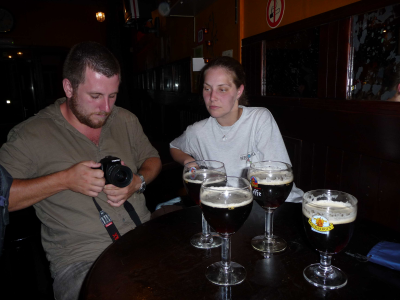
El problema en aquesta fotografia, és que hi ha parts de la imatge que són molt fosques. Les dues persones a la foto estan clares, però el fons és tan fosc que en realitat no podem veure els detalls del bar. Anem a veure què passa si intentem utilitzar l'eina nivells, com hem vist en la primera guia d'aprenentatge:
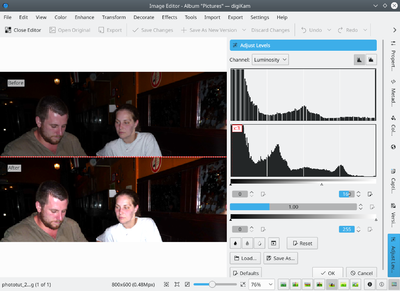
Com podeu veure, algunes parts de la imatge desapareixen si intentem utilitzar l'eina nivells. Què vol dir això? Això vol dir que tenim parts de la imatge al costat dret de l'histograma que han estat convertides a blanc. Això és deu, a diferència de la guia d'aprenentatge anterior, a que aquesta imatge no es concentra sobre la part esquerra de l'histograma. Cobreix la seva totalitat. I quan es retalla l'histograma amb els controls lliscants d'entrada, ens estem «menjant» part de la informació.
Why does this happen? Because the photo scenario had a very High Dynamic Range. i.e. it had objects from very dark (background) to very bright (illuminated by flash).
In this sort of images, if we try moving the input sliders of the levels tool, we will delete part of the photo's gray level information, losing details, and the result isn't nice.
So what to do now? We can use the from the menu : ![]()
Selecting this option will show a new popup with a dialog that may look similar to the levels tool. You can see the resulting histogram on top, and the input histogram on the bottom, just like in the levels tool:
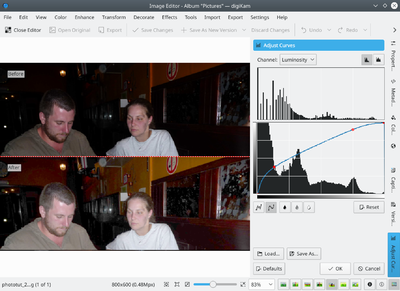
The difference is in the way the control works. In this tool, the input histogram has a diagonal line in it. Clicking on it with the left button of the mouse, adds control points. You can move those control points up or down. The result, as shown in the picture above, is that the gray levels from the horizontal axis are converted into the gray levels in the vertical axis.
Moving the control points up, makes that part of the image brighter. Moving them down, makes that part of the image darker.
In this case, I wanted to make the darkest parts of the image brighter, so I added a control point on the left part of the histogram, and moved the point upwards. As the rest of the image was also getting a bit too bright, I added a second control point to avoid it.
So, lets press and see what we get of it:
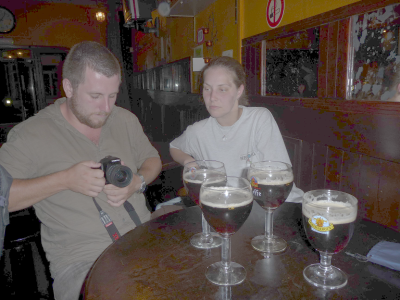
We have managed to make the shadows brighter, and now the pub is more visible, but the image is now a bit washed out. As if it were too bright all over the place. Can we do something? Sure, lets try the levels adjustment again:
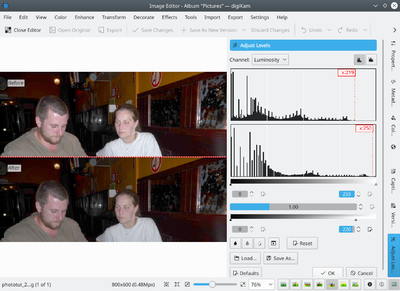
Now that the shadows were adjusted using the curves, and the colors are more uniform, we can follow the method shown in the first tutorial and adjust the levels of the photo, as shown above. The histogram's main data was a bit displaced to the left, and adjusting levels, I made it cover the whole range again.
Lets see the result - Ah, now this is much better. The pub background is much more visible and the two persons are not blown:
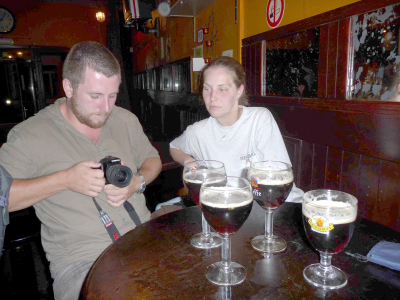
I think that's already acceptable, but if we are picky, the two people are a bit washed out due to the flash light. So, even if that goes out of the scope of this tutorial (it'll be covered in the following tutorials), lets adjust a bit the saturation and contrast in the image for a better result:
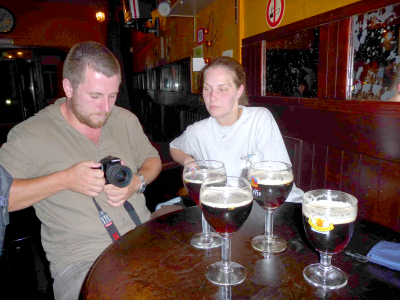
Now this image looks much nicer than the original, yes. I hope you liked this tutorial and will see you in the next one!

